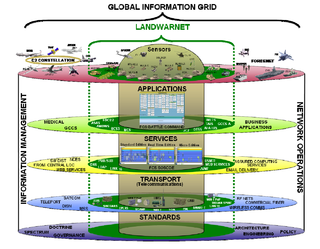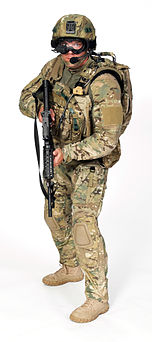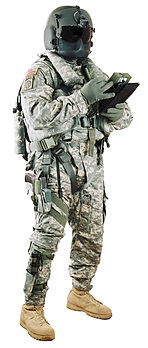The Future Integrated Soldier Technology, sometimes incorrectly referred to as the Future Infantry System Technology or Future Infantry Soldier Technology, is a project by the British Army which aims to enhance the infantry's combat effectiveness in the 21st century as part of the Future Soldier project. The contract was awarded to Thales in March 2003.
The Combat Capabilities Development Command Soldier Center, formerly the United States Army Natick Soldier Research, Development and Engineering Center, is a military research complex and installation in Natick, Massachusetts, charged by the U.S. Department of Defense with the research and development of food, clothing, shelters, airdrop systems, and other servicemember support items for the U.S. military. It is a component unit of the United States Army Combat Capabilities Development Command and is a tenant unit of the United States Army Natick Soldier Systems Center (SSC). The installation includes facilities from all the military services, not just the Army, and is so configured to allow cross-service cooperation and collaboration both within the facility and with the many academic, industrial and governmental institutions in the Greater Boston Area.

Land Warrior was a United States Army program, launched in 1989, officially got its name in 1994, cancelled in 2007 but restarted in 2008, that used a combination of commercial, off-the-shelf technology (COTS) and current-issue military gear and equipment designed to:

Future Combat Systems (FCS) was the United States Army's principal modernization program from 2003 to early 2009. Formally launched in 2003, FCS was envisioned to create new brigades equipped with new manned and unmanned vehicles linked by an unprecedented fast and flexible battlefield network. The U.S. Army claimed it was their "most ambitious and far-reaching modernization" program since World War II. Between 1995 and 2009, $32 billion was expended on programs such as this, "with little to show for it".

Infanterist der Zukunft is the German Bundeswehr's program as part of the Future Soldier project. It is a modular, integrated fighting system designed to provide significant lethality, survivability, mobility, battle command, and training to the German infantryman. It is being developed by EADS Defence Electronics and Rheinmetall-Detec.

The Modular Integrated Communications Helmet (MICH) is a U.S. combat helmet and one of several used by the U.S. military. It was developed by the United States Army Soldier Systems Center to be the next generation of protective combat helmets for use by the U.S. Army.
The Rapid Equipping Force (REF) was a United States Army organization headquartered in Fort Belvoir, Virginia. The organization was charged with quickly providing Army units deployed globally with innovative government off-the-shelf and commercially available solutions that address urgent requirements within 180 days or less. The REF was able to do this through unique authorities and by maintaining a presence near the point of need. REF personnel were positioned in Iraq, Afghanistan, and Kuwait and mobile laboratories are available for quick solutions. Additionally, the REF empowered the Army at a grassroots level, enabling individual soldiers to communicate needs directly through simple request forms.

The FCS Network - Brigade Combat Team (BCT) Network consists of five layers that deliver data to forward-deployed Army units.
The Advanced Combat Man System (ACMS) is part of the Singapore Armed Forces's (SAF) move to integrate into 3G to progressively provide tactical units with network capabilities, including C4I capabilities in the field. The project costs about SG$100 million to maintain.
Air Warrior (AW) is a modular, integrated, rapidly reconfigurable combat aircrew ensemble designed for U.S. Army aircrews. Previous aviation life support equipment consisted of a non-integrated assemblage of protective and survival gear. AW uses a systems approach to equipping the aircrew and closes the capability gap between human and machine. Fielded incrementally in blocks to rapidly provide enhanced capabilities to the warfighter, AW leverages and integrates clothing and equipment, such as the Army Aircrew Combat Uniform and ballistic protection, from other product managers. As of April 2010, more than 18,000 AW systems had been fielded in support of Operation Iraqi Freedom and Operation Enduring Freedom.

The Mounted Soldier System (MSS) or Ground Warrior is a combat vehicle crewman ensemble integrating advanced gear as an effective force multiplier in combat theater.
Program Executive Office Soldier is a US Army organization that is responsible for rapid prototyping, procurement, and fielding of equipment for the soldiers.

The Enhanced Combat Helmet (ECH) is a combat helmet designed in conjunction of a joint program of the United States Marine Corps and United States Army to replace the current combat helmets in use by the U.S. Army, Marines, Navy, and Air Force. Although similar in shape of the Advanced Combat Helmet and its predecessor the Modular Integrated Communications Helmet, the ECH is instead constructed using thermoplastics instead of the ballistic fibers used on previous-generation combat helmets.

The Head Gear System (HGS) is a future headgear ensemble under development by the U.S. Army. HGS attempts to integrate head protection against ballistics, fragmentation, blast, blunt force, flash heat, and noise into a single lightweight, modular, scalable headgear system. Program Executive Office (PEO) Soldier is working to develop a Soldier-centric Head Gear System (HGS) that provides ballistic and traumatic brain injury protection as well as face, neck, and hearing protection. The HGS also will incorporate integrated sensor inputs along with display hardware and software for increased situational awareness. The system will address technology gaps identified by the Capabilities Development Integration Directorate of the Army's Training and Doctrine Command.
Nett Warrior (NW) (formerly known as the Ground Soldier System) is an integrated dismounted leader situational awareness (SA) system for use during combat operations of the United States Army.
TALOS was the name given to a powered exoskeleton, first proposed in 2013, that United States Special Operations Command intended to design with the help of universities, laboratories, and the technology industry. The brief for TALOS stated that it had to be bulletproof, weaponized, have the ability to monitor vitals and give the wearer enhanced strength and perception. The suit would comprise layers of smart material and sensors. The suit may have not been intended for an entire squad, but to protect a lead operator who would breach a door first, the most vulnerable team operator in that situation. TALOS was not a program as such; it has been described as an "effort".

Counter-IED equipment are created primarily for military and law enforcement. They are used for standoff detection of explosives and explosive precursor components and defeating the Improvised Explosive Devices (IEDs) devices themselves as part of a broader counter-terrorism, counter-insurgency, or law enforcement effort.
The Defense Advanced Research Projects Agency (DARPA) Ground X-Vehicle Technology (GXV-T) project is an effort to develop technologies and designs to create lighter future armored military vehicles.

The United States Army Futures Command (AFC) is a United States Army command that runs modernization projects. It is headquartered in Austin, Texas.
The Internet of Military Things (IoMT) is a class of Internet of things for combat operations and warfare. It is a complex network of interconnected entities, or "things", in the military domain that continually communicate with each other to coordinate, learn, and interact with the physical environment to accomplish a broad range of activities in a more efficient and informed manner. The concept of IoMT is largely driven by the idea that future military battles will be dominated by machine intelligence and cyber warfare and will likely take place in urban environments. By creating a miniature ecosystem of smart technology capable of distilling sensory information and autonomously governing multiple tasks at once, the IoMT is conceptually designed to offload much of the physical and mental burden that warfighters encounter in a combat setting.












